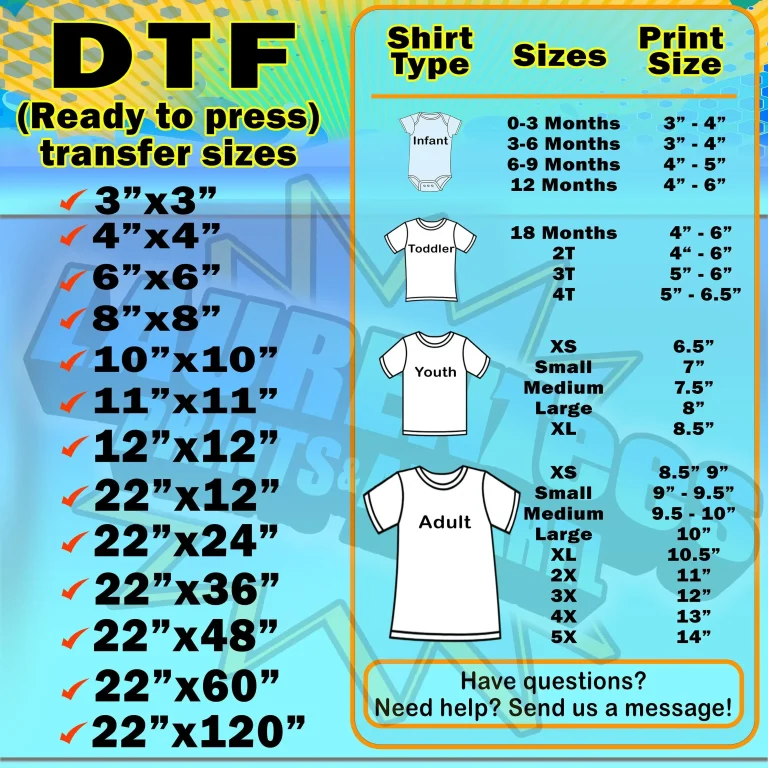DTF transfer by size is a practical strategy for apparel printing teams that want to tailor designs to multiple garment sizes without overproducing. In DTF printing, a single design can be reproduced across various dimensions by adjusting the transfer size, rather than scaling up a single print or producing separate, full-size prints for every size, a common consideration when comparing DTF transfer methods. This approach helps control inventory, reduce waste, and improve precision for smaller runs where accuracy matters most. In this guide, we will explore what DTF transfer by size means, how it stacks up against other DTF transfer methods, and practical criteria for when to use size-based transfers. This overview also touches on DTF printing techniques and how size-based transfers integrate with efficient production workflows.
Alternative terms for this approach emphasize size-aware transfers and scale-based layouts that adapt graphics to each garment dimension. Rather than a single universal print, designers create dimension-specific transfers that preserve legibility and color balance from XS to XXL. This size-aware strategy fits within the broader category of DTF transfer methods and illustrates when to apply dimension-specific layouts in practice. By using templates, calibrated heat-press settings, and fabric-aware adjustments, shops can deliver a consistent brand look across multiple sizes while reducing waste.
Frequently Asked Questions
What is DTF transfer by size and how does it work?
DTF transfer by size is an approach in which multiple transfers are created and scaled for different garment sizes (e.g., XS, S, M, L, XL) rather than relying on a single fixed-size print. Each size band carries tailored artwork to preserve legibility, color balance, and edge quality across the size range. This size-based transfers method reduces waste, improves heat-press precision, and aligns with scalable design practices within DTF printing techniques.
DTF transfer methods: how does DTF transfer by size compare to full-size fixed transfers?
Full-size fixed transfers use one large print for all sizes, which can lead to oversized graphics on small garments and reduced readability on tiny sizes. Size-based transfers optimize legibility and edge definition by sizing the transfer to each garment size, often delivering more consistent color density across sizes. The trade-off is additional design work and a slightly more complex production workflow, which is a common consideration when evaluating DTF transfer methods.
When to use size-based transfers in DTF printing techniques?
Use size-based transfers when you work with mixed-size product lines (XS–XXL) or high-detail designs where small text and fine lines must stay readable. They’re also beneficial for maintaining consistent branding across sizes and for on-demand or personalized orders where size-specific placement matters.
What are practical steps to implement DTF transfer by size (size-based transfers)?
Plan scalable art (prefer vector formats), create defined size bands and templates, calibrate heat-press settings by size, run test swatches on common fabrics, apply proper pre- and post-press steps, validate registration with alignment tools, document a standard workflow (SOP), and continuously test and optimize based on feedback.
What common pitfalls can occur with size-based transfers and how to avoid them in DTF transfer by size?
Pitfalls include neglecting size-specific color calibration, missing reliable templates leading to registration drift, ignoring fabric variation, and underestimating post-press cooling. Avoid these by implementing cross-size color management, building robust templates, testing on each fabric type, allowing proper cooling, and maintaining a clear production SOP.
In what scenarios do size-based transfers deliver the most value compared to other DTF methods?
Size-based transfers excel in boutique lines with diverse sizing, team jerseys and school wear where readability matters across sizes, custom souvenirs with size-aware layout, and on-demand shops serving mixed-size orders. These scenarios benefit from reduced waste, improved legibility, and consistent branding across the size spectrum.
| Aspect | Key Point |
|---|---|
| Understanding DTF transfer by size | Creates multiple transfers scaled to fit XS, S, M, L, XL bands instead of one fixed-size transfer. |
| Size bands and workflow | Define size bands and tailor artwork for each band to preserve legibility and edge quality. |
| Size-based vs other methods | Compared to full-size/fixed transfers, size-based transfers optimize legibility, color balance, and edge quality for each size band. |
| Advantages | Improved legibility; better edge quality; reduced waste; more precise color management and alignment per size. |
| Trade-offs | Increased design workload; higher setup time; more templates and storage; more complex production. |
| When to use | Mixed-size product lines; high-detail designs; branding consistency; short-run or on-demand; personalization. |
| Practical guidelines | Plan scalable art; define size bands; calibrate heat-press by size; test swatches; use alignment tools; maintain SOPs. |
| Pitfalls to watch for | Color calibration drift; alignment template gaps; fabric variation; post-press cooling requirements. |
| Case study | Small-batch brand example showing improved legibility and color depth across sizes with updated templates and calibration. |
Summary
DTF transfer by size offers a structured approach to delivering high-quality graphics across multiple garment sizes. Compared with traditional full-size transfers or one-size-fits-most methods, size-based transfers optimize legibility, edge quality, and color balance for each size band. This approach reduces waste and inventory risk, supports more precise color management, and improves alignment across varying garment dimensions. While it adds upfront design work and a more complex production workflow, proper planning—creating scalable artwork, clearly defined size bands, calibrated heat-press settings, and thorough test swatches—enables a reliable size-based workflow. For boutique printers, on-demand shops, and brands prioritizing consistent presentation across sizes, size-based transfers provide a practical path to delivering consistently strong results from XS to XXL.



